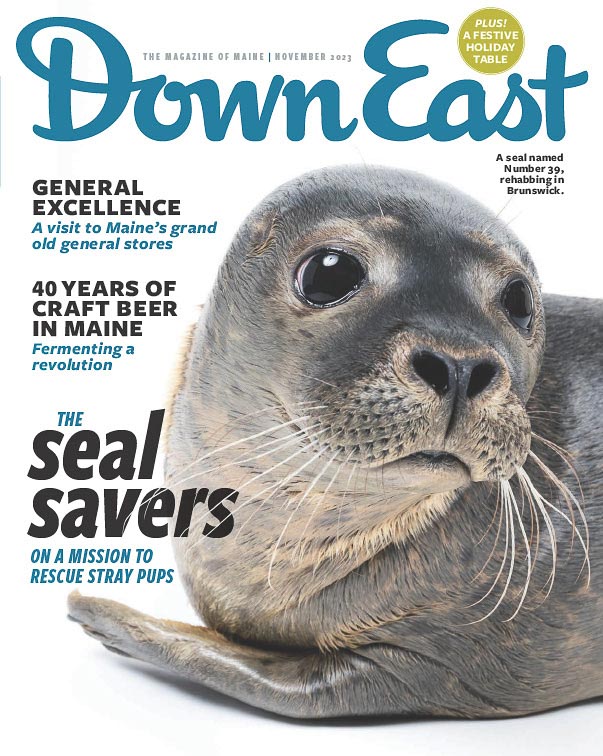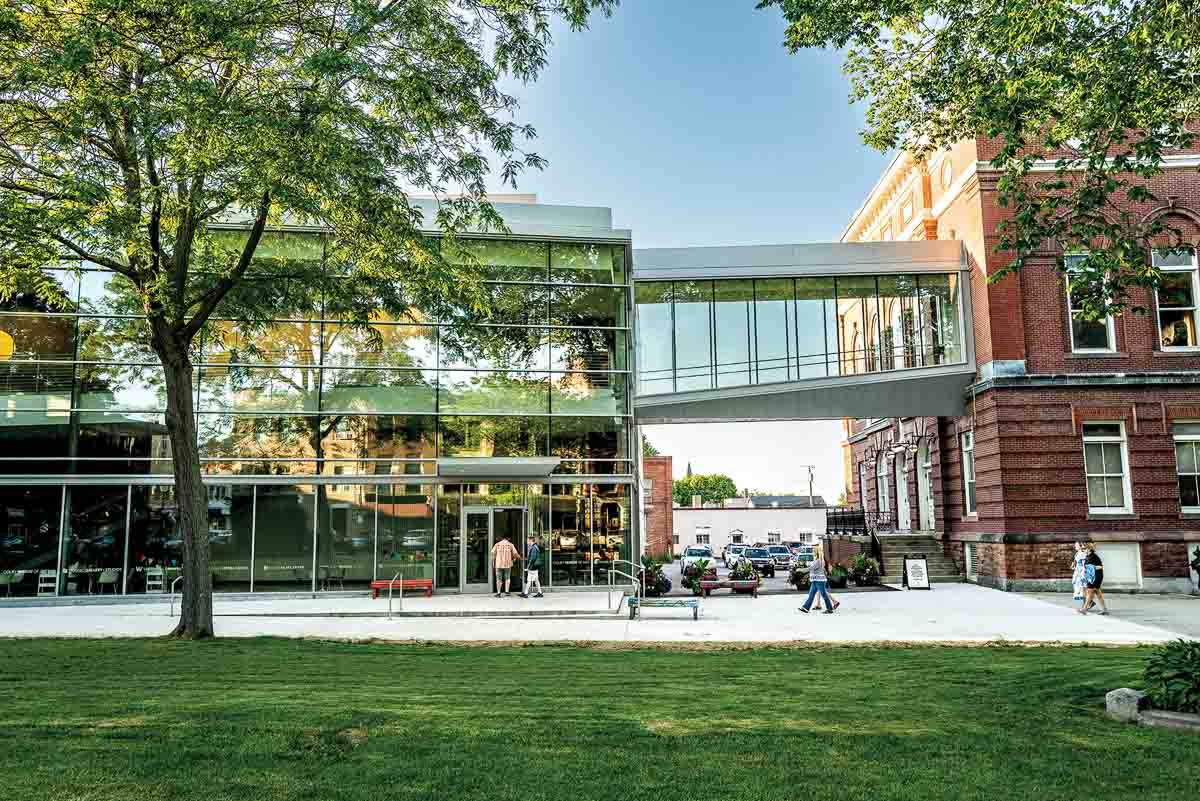By Alexandra Hall
Photos by Séan Alonzo Harris
From our September 2023 issue
First Rangeway is a long residential thoroughfare off Kennedy Memorial Drive, about a mile east of where you might exit I-95. Where it T-bones, you can either turn left, wending your way up Mayflower Hill, home to Colby College’s emerald campus, or you can turn right and soon enough find yourself in downtown Waterville.
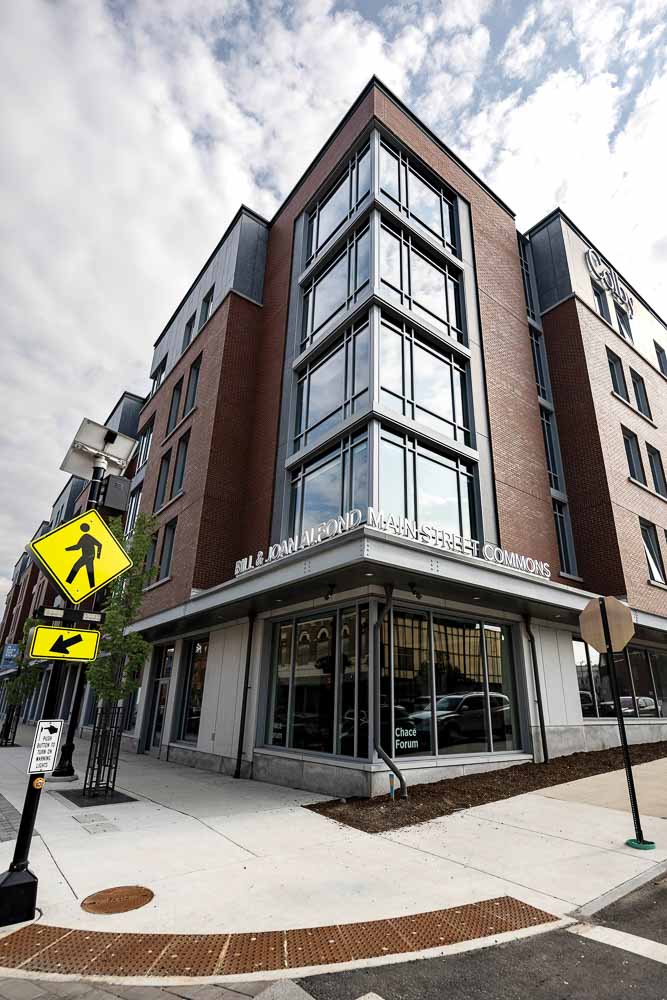
For nearly a century, left has been left and right has been right. To most, the college and the town were worlds unto themselves, and rarely did the twain meet. Today, my husband and I take a right. We zig past his former junior high, then zag up Park Street, a few streets over from the street where he grew up. As we approach downtown Waterville, instead of passing by the “For Lease” signs, tired storefronts, and cracked pavement that have characterized the district for decades, we catch sight of a giant, gleaming sign that now looms over Main Street. It has one word on it: Colby.
The sign sits atop the Bill & Joan Alfond Main Street Commons, a sleek, new $25 million dormitory that was one of the first installments in an ongoing $200 million project to reinvigorate Waterville’s downtown. A collaborative undertaking among Colby, the city, the Harold Alfond Foundation, and plenty of local businesses and community organizations, the effort relies on both private and public funds and has been underway for eight years, aiming to better integrate the college and the town and to create a sustainable economic future for the central Maine city of 16,000.
It’s already had dramatic results. At the south end of Main Street, three blocks from the dorm (and its 2,500-square-foot community-activity space), sits the $26 million Lockwood Hotel, with its boutique-y décor and locavore restaurant, Front & Main. Across from the hotel’s boxy-mod facade, in a former hardware store, is Greene Block + Studios, opened in 2021, with workspace on its upper floors for visiting artists and flexible gallery space downstairs for exhibits, performances, and events.
A block north, the marquee of the $18 million Paul J. Schupf Art Center — proclaiming, simply, “Arts,” in luminous shades of violet and indigo — was lit at the end of last year. Inside are galleries, performance spaces, a café, and three state-of-the-art screens that now host the city’s venerable Railroad Square Cinema. Connected via skybridge is the just-renovated 1902 Waterville Opera House, which is already welcoming big-draw acts like David Sedaris and Ani DiFranco. In July, the arts center and opera house hosted their first Maine International Film Festival.
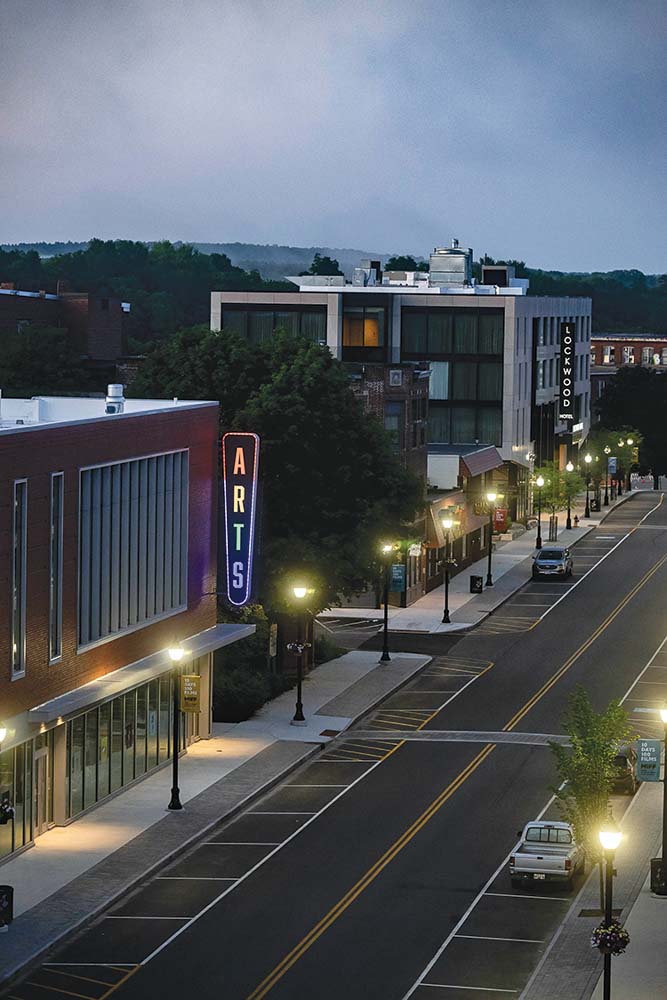


There’s what was once known as the Hains Building, across from the dorm, restored in 2017 to the tune of $6 million. Abandoned for years, it now houses offices and businesses. And then there’s the street itself, once a traffic-choked one-way, now a two-way with new granite curbs and street lighting, flanked by widened, handsome brick sidewalks that invite foot traffic.
Which is the whole point, really: inviting people back. “We asked, ‘How do we help develop downtown so people live and work and lead full lives there again?” says Colby College vice president of planning Brian Clark. Clark came to Waterville in 2014, accompanying then-new college president David Greene. Before that, they’d both been at the University of Chicago, where they worked on a similar initiative together in a blighted neighborhood near campus. “We now have 200 students living in the dorm on Main Street, and they spend money downtown,” he says. “They’re engaged in the community, doing civic work as part of their academic requirements. And we’ve put arts programs and a hotel there, so guests are downtown every night.”
The idea is that more private investment will follow the initial $200 million, and an influx of new businesses and jobs will grow a stronger tax base for the city, along with higher property values that benefit longtime residents even outside the downtown core. Since the investments in downtown began eight years ago, 40 new properties have opened up: a café and market, a yoga studio, a bike shop, an art gallery, and plenty more. Colby reports that since it began buying and developing its Main Street buildings, they’ve gone from generating $42,000 in annual tax revenue for the city to some $500,000.
The reinvention of Main Street seems to be winning over many around Waterville, but by no means all. Beyond the garden-variety wariness of change and some initial squabbles over lost parking, there’s also grumbling from some independent retailers about newly raised rents. Others worry the city lacks enough housing, at both affordable and middle-income levels, for an influx of new Watervillians — including the folks staffing all those new businesses. Feelings are mixed in neighborhoods that aren’t yet seeing a benefit from downtown’s renaissance, and deep wounds and divisions remain across a city that’s worked for decades to address poverty, hunger, crime, and addiction. Given all of that, it remains to be seen whether the ripples from a revitalization effort — even one fueled by so much optimism, expertise, and money — will be felt all the way across Waterville.

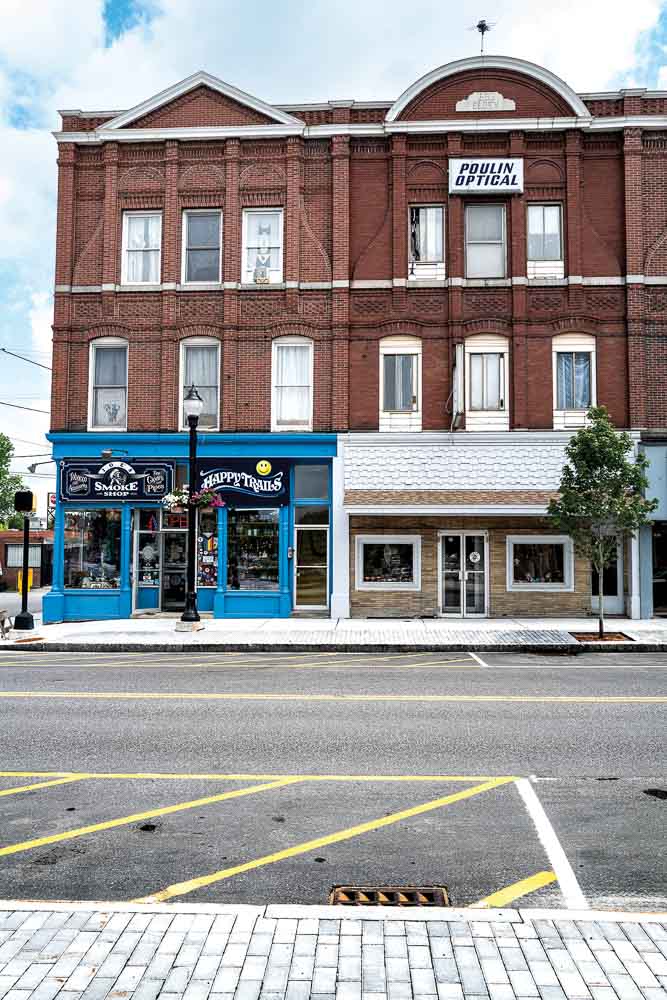

The Howard Miller Room at the Lockwood Hotel is an event space that doubles as a photo-filled shrine to its namesake and the department store that once occupied the site. Miller, who died in 2005, was a lifelong Watervillian, Colby alum, and longtime manager of his family’s business, Levine’s, which opened in 1891 and anchored downtown retail in its mid-century heyday. My husband, David Atallah, who grew up in Waterville in the ’70s remembers the store as a point of connection between the college and community. “It was this haberdashery owned by a pair of twins, Pacy and Ludy Levine, and they were unbelievable salespeople,” David remembers. The Levines were also proud Colby alumni and donors. “It was a ritual for every kid in town to buy your first suit there or pants for the new school year,” David says. “And if you weren’t already going to Colby, they’d try to talk you into going there someday.”
Levine’s closed in 1996. That Colby commemorated it in its new hotel (as well as outside of it, with a stretch of lawn now called Levine’s Park) speaks to an understanding of how much Waterville cherishes its history — and how hard it is to see it disappear.
“When Levine’s was torn down to build the new hotel, that was really emotional for people,” Waterville native Shannon Haines says. As president and CEO of the nonprofit community-arts organization Waterville Creates, she’s now ensconced down the street, in the new Paul J. Schupf Art Center, an edifice she couldn’t have envisioned growing up in the ’80s and ’90s. Haines moved away for college but returned in 1998 to her hometown, where for years she ran the nonprofit Waterville Main Street. In 2014, she helped form Waterville Creates, which today encompasses the city’s largest arts and cultural entities. “Waterville has the oldest and largest art museum in the state,” she says. “The largest and longest-running film festival in the state. The only Sundance Art House theater in the state. A 100-year-old opera house. A national-medal–winning library. These are huge assets that are here because the community has supported them.”
I ask her about a mural in the Schupf Center, a painting of the Two Penny Bridge, which spans the Kennebec River, connecting Waterville to neighboring Winslow. The work of local artists Elizabeth Jabar and Colleen Kinsella, it’s emblazoned with the phrase “Be a Bridge.” “It’s a symbol of connecting two communities,” Haines tells me. “And that’s what we’re doing here.”



When Colby, originally called the Maine Literary and Theological Institution, was founded, in 1813, there was no need for a bridge — the school was located downtown. Though not yet incorporated, Waterville was a mill town on the rise, a center for agriculture, shipbuilding, and lumbering. In 1930, with the college outgrowing its site and considering relocating to Augusta, Waterville citizens raised $100,000 to buy land two miles from downtown, on Mayflower Hill, for a new campus.
Waterville in the rest of the 20th century followed a familiar mill-town arc. For decades, its robust economy was fueled by factories and paper and textile mills along the Kennebec, as well as by immigrants — prominently Québécois and Lebanese — seeking good wages. Then, starting in the 1950s, mills began moving where labor was cheaper, first to the American South and then abroad, until the forces of globalization and mechanization in the ’80s ushered in an era of mill closures. Mid-century urban-renewal efforts razed much of Waterville’s downtown, and the construction of I-95, bypassing the city center, brought big-box stores that supplanted what was left of it. Houses once occupied by mill workers, surrounding downtown, were replaced by parking lots, discount retail stores, and several banks. Plenty of Waterville residents moved away, and those who stayed struggled to find work.
“The middle class was gutted for a while,” is how my husband remembers it. “When I was a kid, you still had friends whose parents worked in the mills and had a steady paycheck. Not everyone had the same income, but they all still felt pride and could put food on the table.”
The gutting has had lasting effects. Census data from 2022 reports 23.1 percent of Waterville households living below the poverty line. The town’s median household income is $41,245, more than $20,000 below the state’s average — and more than $40,000 less than the full tuition rate for a single year at Colby.

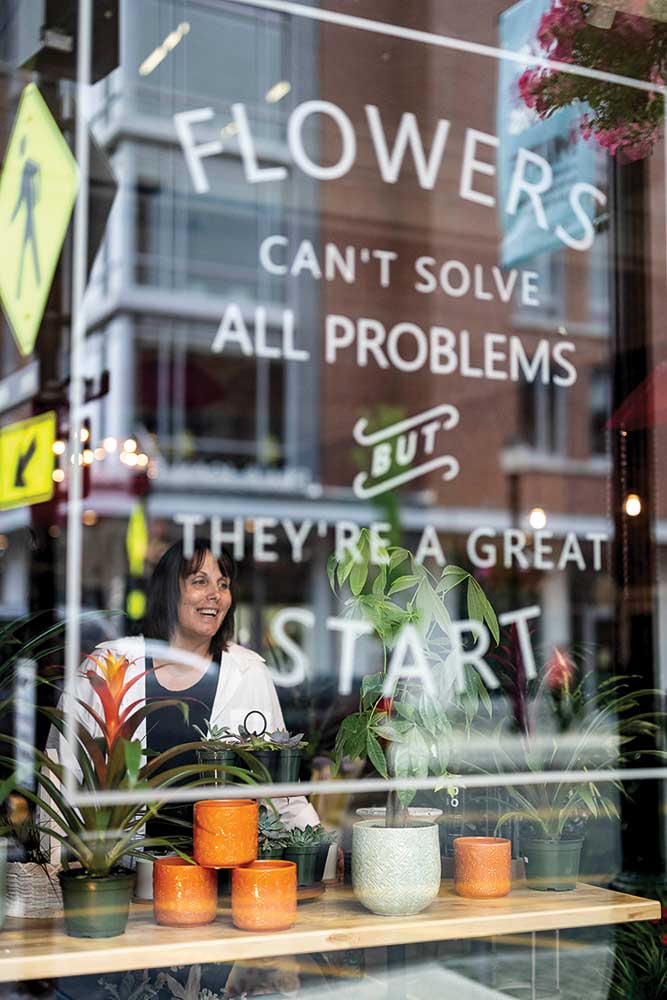

The persistence of that disparity is what troubles some who very much want the revitalization project to succeed — folks like native Watervillian Kathleen O’Halloran, the executive director of LifeFlight of Maine and a former associate director at Colby’s Goldfarb Center for Public Affairs. “I want to be clear that I love Colby,” she explains. “I grew up in a Colby family. My grandparents and brother and two nieces went there, my dad got the Colby alumni award. I grew up in the ’70s, and I didn’t see any distinction between the town and Colby — they were vibrant places, and I felt there was a strong middle class in town.” She left Maine for college, and when she returned, in 2003, the dynamic felt different. “There was a whole faction of the community who would never come to Colby for an event,” O’Halloran says. “It felt like an elite institution, and people from town didn’t feel welcome. So what’s happening now is what needed to happen.”
But O’Halloran, who now lives just outside Waterville, in Fairfield, wonders if some of that money and energy might have been better directed. “I’m really torn, because I’m grateful every day for the investments that Colby’s made. And it’s not Colby’s job to fix Waterville. But I’m also very aware of the big problems that are still there,” she says. “From what I see, what Waterville needs is a way to feed the kids in town. A way to deal with the drug prevalence and the poverty and violence. I worry that it’s a matter of time before we might have a violent event in the dorm on Main Street.” Last spring, a fight between three Waterville men at a party in a dorm on Colby’s Mayflower Hill campus led to gunfire, a lockdown, and an arrest. If a long-range goal of downtown redevelopment is to help address Waterville’s broader social problems, O’Halloran says, “I really worry about whether this is going to work.”
If anyone could convince you it might, it’s John Phillips-Sandy. Another boomerang Watervillian, returned after a college stint, he’s director of food and beverage at Front & Main, the Lockwood Hotel’s restaurant. Sitting beneath swanky, retro light fixtures in the restaurant’s bar, the thirtysomething is clearly invigorated by the possibilities ahead for Waterville. “This is a place that’s chosen to be a strong community,” he says. “That strengthens its appeal for people like me to come back and for new people to come in.”
The mills were already all closed when Phillips-Sandy was growing up. Waterville’s population was at the nadir of a 40-year slide. The arts scene, however, was already vibrant — Phillips-Sandy’s mom was a community-theater producer at the opera house and later the first director for the Maine International Film Festival. Looking out the window, he gestures to a huge mural on the side of the adjacent building, an homage to the Lebanese-American immigrants who’ve helped shape the city.
“That mural didn’t exist when I was growing up,” Phillips-Sandy says. My husband, who’s half Lebanese, leans in. “That’s Al Corey’s sax,” Phillips-Sandy goes on, pointing out the instrument in the mural’s corner. “I bought my first saxophone at his music store. I remember once, Al’s band was playing, and one of the player’s wives went into labor and I got the call — and I got to play with Al!” The experience steered him to studying jazz in college. “And in a way,” Phillips-Sandy says, “it helped to shape my path to want to come back here.”
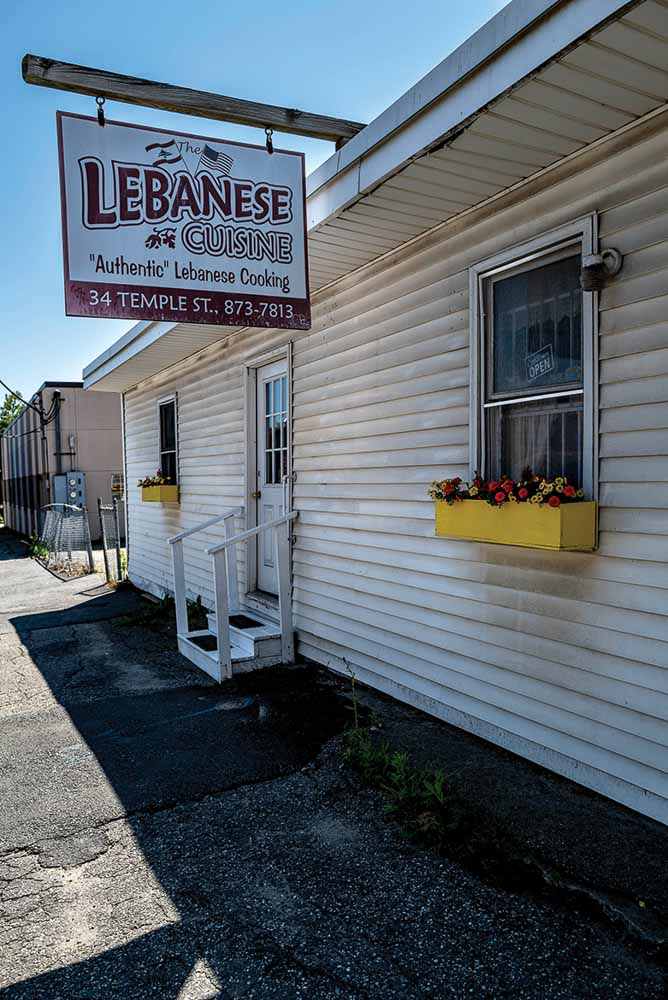
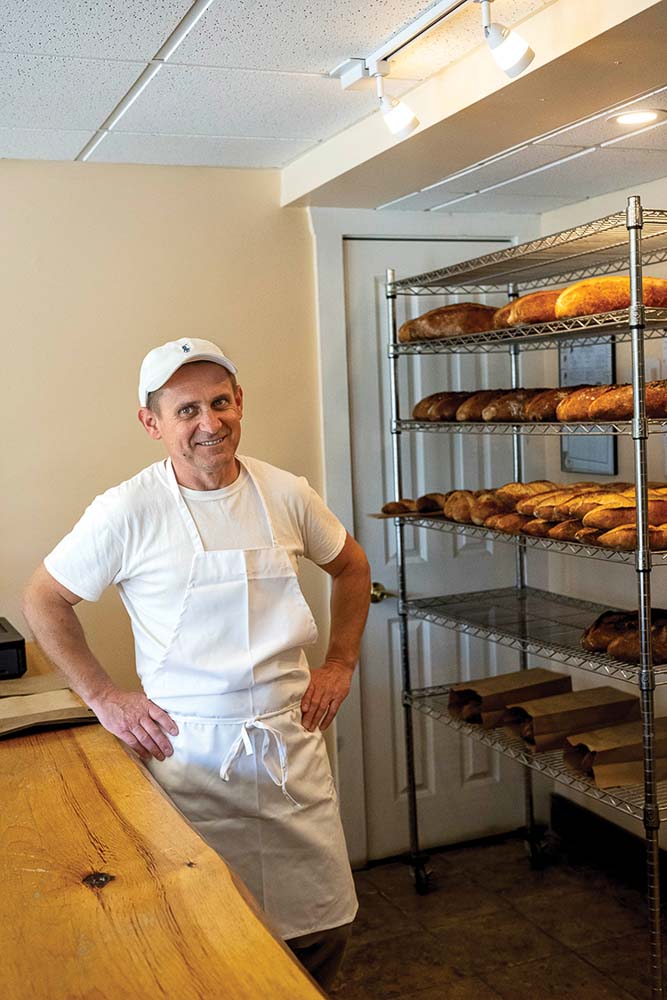

When he did, he was lucky to snag an apartment in the mixed-use Hathaway Creative Center, in the former Hathaway Mill, across Spring Street from the hotel. “When I was a kid it was largely an unused space,” he remembers. Developed by Colby alum Paul Boghossian, it spearheaded Waterville’s downtown revitalization, in 2017, and is currently a mix of apartments and businesses, including Hathaway Mill Antiques and Waterville Brewing Company. It’s also home to Dirigo Labs, a startup accelerator program that’s helping incubate small businesses (this year’s cohort includes a Rockland company making plant-based construction materials and a Millinocket-based renewable-energy company).
“My unit faces the Waterville-Winslow bridge and the Kennebec River,” Phillips-Sandy says. “At the end of my day, I look out, and it feels like I’m living in an emerging, growing city. But it also has this connection to the city it used to be. The mill where I sleep was where entire Canadian and Lebanese families used to work.”
If his unit faced the opposite direction, however, it would look out over the South End neighborhood, on the other side of Bridge Street from downtown, where rows of dense triple-deckers and vacant lots don’t yet suggest any spillover prosperity from the new investment. After the mills closed, the French-Canadian families who lived on the South End largely left, and the once tight-knit area became run-down and crime-ridden. In 2001, some residents got fed up and formed the South End Neighborhood Association, an effort to control drug activity and improve the area.
“We’ve managed to get the city to repave some sidewalks and roads,” says Anna Holdener, who’s lived in Waterville for 13 years and been chair of the association for eight. “But that was after we’d been neglected for a long time.” Crime is still a problem, she says — break-ins, drug use, violence — though there have been fewer incidents over the last few years. “There’s an area on the nature path where you still find drug paraphernalia and people living,” she says. “But we’re just a small group of residents, and we can only do so much.”
Neighborhood volunteers have renovated green spaces, established a teen center, and held twice-annual clean-up days — at which she estimates 25 to 30 Colby students from the new downtown dorm help them. Other than that, it seems, benefits from the downtown redevelopment have yet to trickle over. “We don’t feel a regular impact from it yet,” Holdener says. “We’ve been working on trying to improve things here long before that started. But there’s a long history of bias in town against the South End, and a lot of people feel we’re not welcome downtown because it’s all new, shiny things there now.”
“One criticism we’ve heard,” says Clark, Colby’s planning officer, “is, ‘Why is Colby investing in downtown when places all over Waterville need it?’ But we feel things emanate from that downtown investment.” The prior weekend, he says, he took his son to a new playground on the other side of town, built with tax revenue from the new downtown developments. “So you’re seeing projects happen beyond downtown that are 20 or 30 years overdue.”
He also points out that property values are going up. “That’s the primary source of wealth for a lot of people in this area,” Clark says. “Then, going forward, these investments will generate population growth.”
Improvements in one arena, of course, often create needs in others. “Jobs have increased, but now our biggest barrier is housing,” Waterville mayor Jay Coelho says. “We don’t have anywhere to put employees.” But the city’s addressing it, he says, with “two or three developments” already on the near horizon, such as a new mixed-use complex with two five-story buildings and 63 apartments (18 of which would be affordable housing).
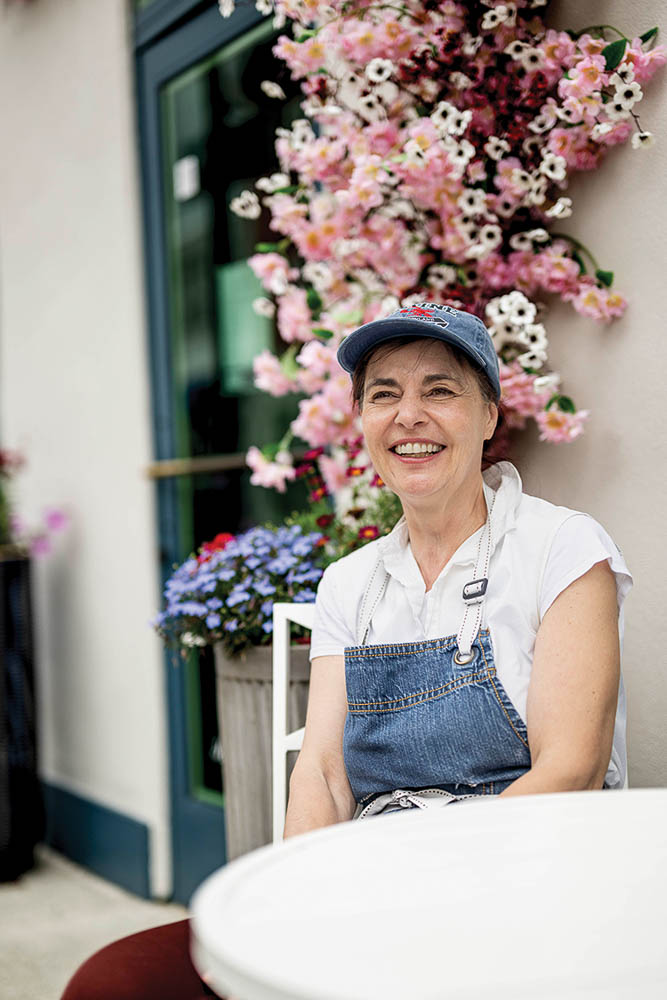
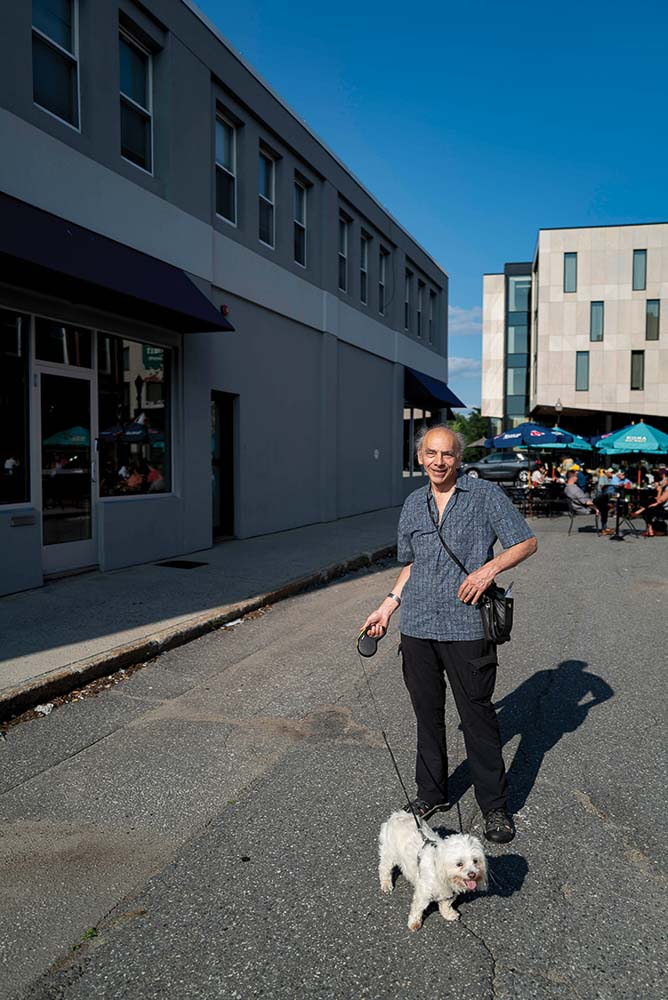

Meanwhile, rising retail rents worry some downtown business owners — even a few otherwise thrilled with the street’s progress blame above-market prices for storefronts that are currently sitting empty. “It’s been wonderful to have so much foot traffic, and so many people coming in before shows at the opera house,” says Tanya McCarthy, who owns Wild Clover Café and Market. But she says she couldn’t afford to be there if she hadn’t bought her building. “The rents are very high, so owning our own place was the only way to make it work. We got lucky and were able to, but high rents aren’t helpful to keep the Main Street momentum going.”
Anecdotally, some in the community are noticing incremental progress on longstanding problems. At the Alfond Youth and Community Center, CEO Ken Walsh sees 200 Waterville kids roll up in buses for after-school care, where they get hot meals and access to a slew of activities, regardless of their economic circumstances. “Food insecurity for kids in Waterville is high, but it’s far less than it was 30 years ago,” Walsh says. He’s seen it diminish in the last five or six years, he says, ever since “community leaders started talking with each other more and creating better partnerships.”
As with the South End Neighborhood Association, the Alfond Center also welcomes between 20 and 30 Colby student volunteers each semester. “You get highly talented students here mentoring, and you see a five-year-old kid get visions of higher ed because of that relationship,” Walsh says. “That’s huge.” He also points out the center’s internship and hiring programs with Waterville’s Thomas College and Kennebec Valley Community College. “The only way this works,” he says, “is if we all do it together.”
The new spirit of togetherness is in evidence on Mayflower Hill too. This fall, Colby opens its $85 million Gordon Center for Creative and Performing Arts, a 74,000-square-foot building sited at the gateway to the campus. In addition to housing the academic programs for theater, dance, music, and cinema studies, the state-of-the-art facility will include a 300-seat hall and other performance and exhibition spaces. And part of the opening, Clark says, is a concerted campaign to invite all of Waterville in for shows, festivals, and other events. “It’s meant to be that bridge to the campus for the community,” he says.
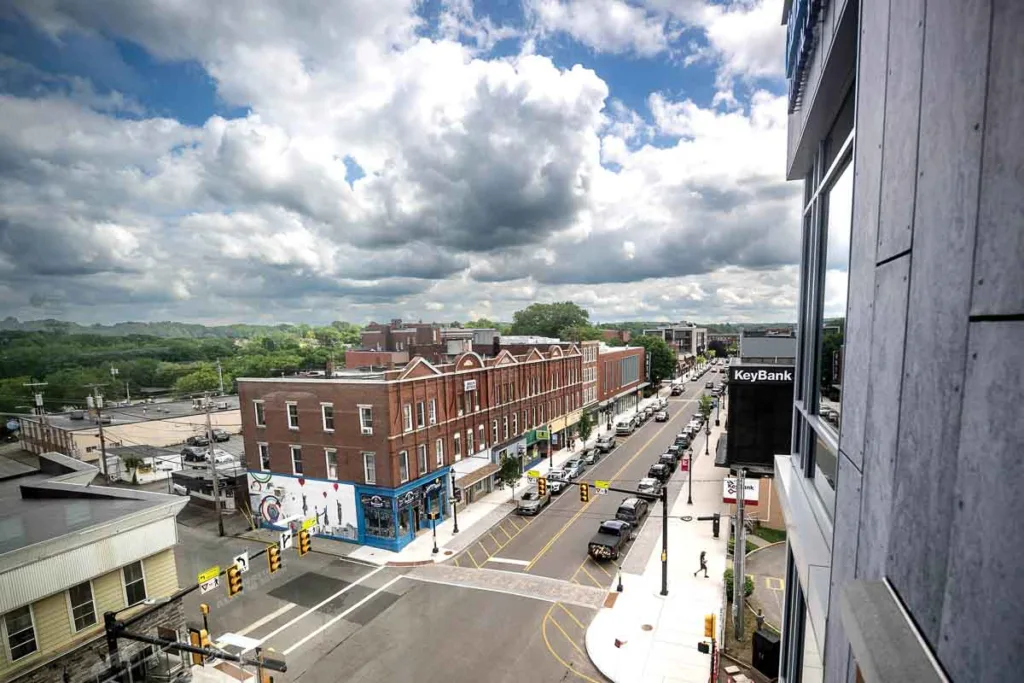
There’s that word again: “bridge.” Like on the mural in the Schupf Art Center, seen by the hundreds of Waterville kids who’ve already come in for tours of the new space. “We always tell them: ‘We built this building for you,’” says Waterville Creates’s Haines. “It’s meant for the local community, and everyone’s welcome. Our biggest goal is to make people understand that art is for everybody, in their everyday life.”
There’s an urgency in her voice as she tells me this. So I ask about the chicken-and-egg conundrum: if some Watervillians say they don’t feel welcome in the fancy new spaces — in part because they’re so nice — how do you get them in the door to convince them it’s for them?
“That’s the million-dollar question we’re constantly asking ourselves,” Haines says. “What’s relevant? What’s local? How do we use a language that’s understandable? We need to keep offering an invitation to people. And if they don’t accept it right away . . . .” She pauses for a second, then finishes, more urgently still, “We just need to keep saying, please come in.”
